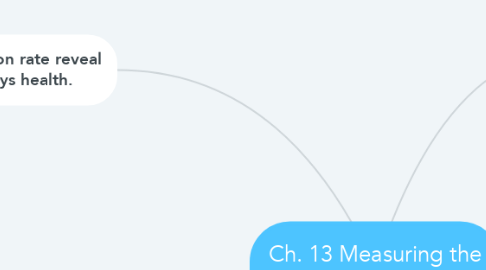
1. How do Econimists measure the size of the economy?
1.1. The main measure of the size of a nation's economy is its gross domestic product. GDP is an economic indicator that measures a country's totl economic output.
1.1.1. Final Good- any new good that is ready for use by a consumer.
1.2. To compensate for the effects of inflation the commerce department calculates what is called real GDP.
1.2.1. Net Exports- the value of all exports minus all imports
1.3. real GDP, a measure of a country's economic output valued in constant dollars, real GDP refelects the effects of inflation
1.3.1. Constant Dollars- fixed at a rate that was current in a specified base year.
1.4. Economic's use GDP figures to determine not only how big an economy is but wheather it is growing or shrinking and at what rate.
1.4.1. Current Dollars- reflects the purchasing power of the dollars in the year they are spent.
2. What does the Unemployment Rate tell us about an Economy's health?
2.1. Like the GDP, the unemployment rate is a useful indicator of the health of an economy. In general a high unemployment rate means the overall health of the economy is poor.
2.1.1. Unemployment Rate- the percentage of the labor force that is seeking work.
2.2. When an economy reaches full employment, jobs exisit for everyone who wants to work even though a certain % of those jobs and workers will not yet have matched together.
2.2.1. Frictional Unemployment-It applies to people who change jobs as well as to people seeking their first jobs.
2.3. The first problem is that at any one time a number of unemployed people have given up looking for work. The second problem is that official unemployment rate does not reconize involuntary part time workers. The third problem witht he unemployment rate involves people working in informal or underground economies.
2.3.1. Structural Unemployment- comes about mainly when advances in technology reduce the demand for certain skills.
2.4. Members of the labor force who have jobs are classified as employed. Members of the labor force who are jobless but are looking for work, are classified as unemployed
3. What does inflation rate reveal about an economys health.
3.1. The german experenice was proof if any was needed, that runaway inflation can send an economy into tailspin. That is why economists keepa close eye on a third economic indicator.
3.1.1. Price Index- measures the average change in price of a type of good over time.
3.2. The cost of current dollars of all the nasic goods an services that people need is the nominal cost of living. The real cost of living is the nominal cost of basic goods and services, adjusted for inflation
3.2.1. Inflation rate- the percentage increase in the average price level of goods and services from one month or year to the next
3.3. The BLS tracks inflation by gathering information on Americans cost of living. That is it stidies the cost of buying the goods and servies that households like your purchases everyday. As you would expect the cost of living changes all the time because prices do not stay the same
3.3.1. Nominal wages- Wages based on current price.

